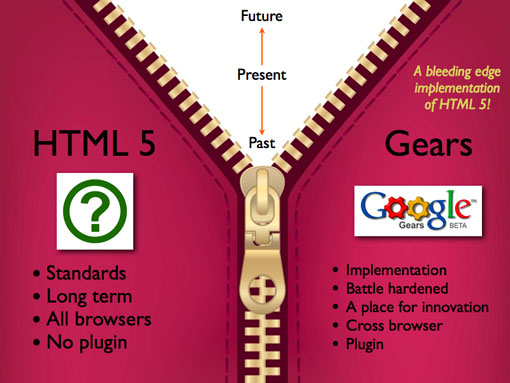iPhone Web applications and the Record API
As we watch and wait for the update to the Google Mobile iPhone application we are once again aware of the gatekeeper situation on that platform.
Google doesn’t know when it will launch, Apple does. Google had great PR into the launch (which they were told would be Friday… at least at some point). I had the pleasure to see the voice feature and was actually kinda gobsmacked with it when I saw it at work. It isn’t like we haven’t seen voice recognition apps for years. However, this one seemed to actually work, and not just for simple words but for complex queries. Random place names were picked up. Wow. Maybe the work behind GOOG-411 is paying off :)
But, the iPhone app isn’t out there, yet. If this was a Web application, the Google engineers could cut a release and be on their way. But, how would you read in the audio? You could go for Flash or a custom plugin, but it reminded me of the audio API support and Gears. When you think Audio API you think of the HTML 5 audio tag and the API that goes with it… specifically the “play” support. What interested me from the first design doc in Gears was the other side of things and the support for “record”:
// an object of this class can be got from // google.gears.factory.create('beta.audiorecorder') AudioRecorder class { // ---- error state ---- readonly attribute AudioRecorderError error; // ---- recording state ---- // says whether recorder is currently recording or not readonly attribute boolean recording; // says whether recorder is paused or not readonly attribute boolean paused; // the amount of sound detected by the microphone // 0 - no sound detected to 100 - maximum sound detected readonly attribute int activityLevel; // specifies the length (in milli seconds) of the audio recorded readonly attribute float duration; // number of channels, currently can be 1 (mono) or 2 (stereo) attribute int numberOfChannels; // sample rate for the recording attribute float sampleRate; // sample type for the recording, possible values need to be defined // signed 16 bit little endian linear PCM const unsigned short S16_LE = 0; attribute short sampleFormat; // audio file type (container and codec), possible values need to be defined attribute string type; void record(); void pause(); void unpause(); void stop(); // ---- controls ---- // 0.0 - silent to 1.0 - loudest attribute float volume; attribute boolean muted; // the amount of sound required to activate the microphone // 0 - capture even minutest sound to 100 - capture only loudest sound attribute int silenceLevel; // ---- cue ranges ---- // provides ability to set callbacks at specific points in playback time. // similar to API in Audio class. Look at HTML5 spec for explanation. void addCueRange(in DOMString className, in float start, in float end, in boolean pauseOnExit, in VoidCallback enterCallback, in VoidCallback exitCallback); void removeCueRanges(in DOMString className); // ---- access blob ---- // returns handle to the blob object containing the audio data Blob getBlob(); };
I can’t wait to get full audio support available in the Open Web itself. Yet another barrier knocked down. Of course, the publicity around the Google Mobile app is nothing but good in many ways :)









